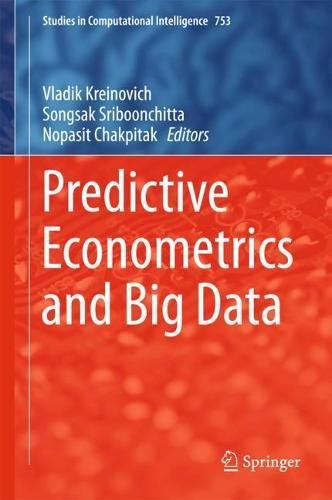
Predictive Econometrics and Big Data
- Length: 780 pages
- Edition: 1st ed. 2018
- Language: English
- Publisher: Springer
- Publication Date: 2018-01-06
- ISBN-10: 3319709410
- ISBN-13: 9783319709413
- Sales Rank: #5860965 (See Top 100 Books)
This book presents recent research on predictive econometrics and big data. Gathering edited papers presented at the 11th International Conference of the Thailand Econometric Society (TES2018), held in Chiang Mai, Thailand, on January 10-12, 2018, its main focus is on predictive techniques – which directly aim at predicting economic phenomena; and big data techniques – which enable us to handle the enormous amounts of data generated by modern computers in a reasonable time. The book also discusses the applications of more traditional statistical techniques to econometric problems.
Econometrics is a branch of economics that employs mathematical (especially statistical) methods to analyze economic systems, to forecast economic and financial dynamics, and to develop strategies for achieving desirable economic performance. It is therefore important to develop data processing techniques that explicitly focus on prediction. The more data we have, the better our predictions will be. As such, these techniques are essential to our ability to process huge amounts of available data.
Table of Contents
Chapter 1. Data in the 21st Century
Chapter 2. Model-Assisted Survey Estimation with Imperfectly Matched Auxiliary Data
Chapter 3. COBra: Copula-Based Portfolio Optimization
Chapter 4. Multiple Testing of One-Sided Hypotheses: Combining Bonferroni and the Bootstrap
Chapter 5. Exploring Message Correlation in Crowd-Based Data Using Hyper Coordinates Visualization Technique
Chapter 6. Bayesian Forecasting for Tail Risk
Chapter 7. Smoothing Spline as a Guide to Elaborate Explanatory Modeling
Chapter 8. Quantifying Predictive Uncertainty Using Belief Functions: Different Approaches and Practical Construction
Chapter 9. Kuznets Curve: A Simple Dynamical System-Based Explanation
Chapter 10. A Calibration-Based Method in Computing Bayesian Posterior Distributions with Applications in Stock Market
Chapter 11. How to Estimate Statistical Characteristics Based on a Sample: Nonparametric Maximum Likelihood Approach Leads to Sample Mean, Sample Variance, etc.
Chapter 12. How to Gauge Accuracy of Processing Big Data: Teaching Machine Learning Techniques to Gauge Their Own Accuracy
Chapter 13. How Better Are Predictive Models: Analysis on the Practically Important Example of Robust Interval Uncertainty
Chapter 14. Quantitative Justification for the Gravity Model in Economics
Chapter 15. The Decomposition of Quadratic Forms Under Skew Normal Settings
Chapter 16. Joint Plausibility Regions for Parameters of Skew Normal Family
Chapter 17. On Parameter Change Test for ARMA Models with Martingale Difference Errors
Chapter 18. Agent-Based Modeling of Economic Instability
Chapter 19. A Bad Plan Is Better Than No Plan: A Theoretical Justification of an Empirical Observation
Chapter 20. Shape Mixture Models Based on Multivariate Extended Skew Normal Distributions
Chapter 21. Plausibility Regions on Parameters of the Skew Normal Distribution Based on Inferential Models
Chapter 22. Measures of Mutually Complete Dependence for Discrete Random Vectors
Chapter 23. To Compare the Key Successful Factors When Choosing a Medical Institutions Among Taiwan, China, and Thailand
Chapter 24. Forecasting Thailand’s Exports to ASEAN with Non-linear Models
Chapter 25. Thailand in the Era of Digital Economy: How Does Digital Technology Promote Economic Growth?
Chapter 26. Comparing Linear and Nonlinear Models in Forecasting Telephone Subscriptions Using Likelihood Based Belief Functions
Chapter 27. Volatility in Thailand Stock Market Using High-Frequency Data
Chapter 28. Analysis of Thailand’s Foreign Direct Investment in CLMV Countries Using SUR Model with Missing Data
Chapter 29. The Role of Oil Price in the Forecasts of Agricultural Commodity Prices
Chapter 30. Does Forecasting Benefit from Mixed-Frequency Data Sampling Model: The Evidence from Forecasting GDP Growth Using Financial Factor in Thailand
Chapter 31. A Portfolio Optimization Between US Dollar Index and Some Asian Currencies with a Copula-EGARCH Approach
Chapter 32. Technical Efficiency Analysis of China’s Agricultural Industry: A Stochastic Frontier Model with Panel Data
Chapter 33. Forecasting the Growth of Total Debt Service Ratio with ARIMA and State Space Model
Chapter 34. Effect of Macroeconomic Factors on Capital Structure of the Firms in Vietnam: Panel Vector Auto-regression Approach (PVAR)
Chapter 35. Emissions, Trade Openness, Urbanisation, and Income in Thailand: An Empirical Analysis
Chapter 36. Analysis of Risk, Rate of Return and Dependency of REITs in ASIA with Capital Asset Pricing Model
Chapter 37. Risk Valuation of Precious Metal Returns by Histogram Valued Time Series
Chapter 38. The Understanding of Dependent Structure and Co-movement of World Stock Exchanges Under the Economic Cycle
Chapter 39. The Impacts of Macroeconomic Variables on Financials Sector and Property and Construction Sector Index Returns in Stock Exchange of Thailand Under Interdependence Scheme
Chapter 40. Generalize Weighted in Interval Data for Fitting a Vector Autoregressive Model
Chapter 41. Asymmetric Effect with Quantile Regression for Interval-Valued Variables
Chapter 42. The Future of Global Rice Consumption: Evidence from Dynamic Panel Data Approach
Chapter 43. The Analysis of the Effect of Monetary Policy on Consumption and Investment in Thailand
Chapter 44. Investigating Relationship Between Gold Price and Crude Oil Price Using Interval Data with Copula Based GARCH
Chapter 45. Simultaneous Confidence Intervals for All Differences of Means of Normal Distributions with Unknown Coefficients of Variation
Chapter 46. Forecasting of VaR in Extreme Event Under Economic Cycle Phenomena for the ASEAN-4 Stock Exchange
Chapter 47. Bayesian Empirical Likelihood Estimation for Kink Regression with Unknown Threshold
Chapter 48. Spatial Choice Modeling Using the Support Vector Machine (SVM): Characterization and Prediction







